|
|
 |
|
Calanoida ( Order ) |
|
|
|
Clausocalanoidea ( Superfamily ) |
|
|
|
Euchaetidae ( Family ) |
|
|
|
Paraeuchaeta ( Genus ) |
|
|
| |
Paraeuchaeta barbata (Brady, 1883) (F,M) | |
| | | | | | | Syn.: | Euchaete barbata Brady, 1883 (p.66, Descr.F, figs.F);
Euchäta barbata : Giesbrecht, 1892 (p.246, 248, 772,);
Euchaeta barbata : T. Scott, 1894 b (p.58, fig.F); Giesbrecht & Schmeil, 1898 (p.40, Rem. F); Sars, 1902 (1903) (p.41, figs.F,M); Thompson & Scott, 1903 (p.234, 244); Pearson, 1906 (p.17, Rem.); Damas & Kofoed, 1907 (p.400, tab.II); Farran, 1908 b (p.40, figs.F); With, 1915 (p.174, figs.F,M); Farran, 1926 (p.256, Rem.); Vervoort, 1957 (p.6, 83, Rem.); 1963 b (p.166, Rem.); Owre & Foyo, 1967 (p.52, figs.F,M, Rem.); Grice & Hulsemann, 1967 (p.15); 1968 (tab.2); Vives & al., 1975 (p.42, tab.II); Park, 1975 c (p.9, figs.F,M); Deevey & Brooks, 1977 (p.256, tab.2, Station "S"); Park,1978 (p.259, figs.F, Rem.); Buchanan & Sekerak, 1982 (p.41, Table 2: vertical distribution, Rem.: p.48); Longhurst, 1985 (tab.2); Hopkins Torres, 1988 (tab.1); Suarez & al., 1990 (tab.2); Suarez, 1992 (App.1); Mauchline, 1992 (p.131, Rem., zoogeo.); 1992 a (p.2, 3); 1994 a (p.561); Richter, 1994 (tab.4.1a); Mauchline,1999 (n°182, p.8, figs.F,M); Hsiao & al., 2010 (p.179, Table III, trace metal concentration);
no Paraeuchaeta barbata : A. Scott, 1909 (p.70, figs.F);
Euchaeta porrecta Sars, 1905 b (p.16);
Paraeuchaeta sarsi A. Scott, 1909 (p.75, figs.M);
? Euchaeta robusta Wolfenden, 1911 (p.299, figs.F);
Euchaete farrani With, 1915 (p.172, figs.F); Vervoort, 1957 (p.6, 83); Park, 1978 (p.263, figs.F,M);
Euchaeta farrani : Grice & Hulsemann, 1967 (p.15); Park, 1978 (p.263, figs.F,M,Rem.); Ward & Wood, 1988 (p.45, tab.1); Øresland & Ward, 1993 (p.73, diet); Richter, 1994 (tab.4.1a);
Pareuchaeta Farrani : Farran, 1929 (p.208, 240, Rem.); Jespersen, 1934 (p.79, Rem.); Hardy & Gunther, 1935 (p.161); Jespersen, 1940 (p.32); Østvedt, 1955 (p.15: Table 3, p.66); Ward & Shreeve, 2001 (p.50, tab.4);
Pareuchaeta barbata : Sars, 1925 (p.112, figs.F,M); Jespersen, 1934 (p.78); 1940 (p.32); Lysholm & al., 1945 (p.23); C.B. Wilson, 1950 (p.276, Rem.); Brodsky, 1950 (1967) (p.209, figs.F,M); Tanaka, 1958 (p.338, figs.F, Rem.); Harding, 1966 (p.17, 29, figs.F); Tanaka & Omori, 1967 (p.245); 1968 (p.225, figs.F); Dunbar & Harding, 1968 (p.319, 320); Vinogradov, 1968 (1970) (p.266); Ramirez, 1969 (p.65, figs.F, Rem.); Vidal, 1971 a (p.16, 117, figs.F); Heptner, 1971 (p.77, figs.F,M); Vives, 1982 (p.291); Guangshan & Honglin, 1984 (p.118, tab., Rem.: p.165); Lozano Soldevilla & al., 1988 (p.58); Mauchline, 1998 (tab.42); Auel, 1999 (tab.2); Kosobokova & Hirche, 2000 (p.2029, tab.2); Holmes, 2001 (p.52); Auel & Hagen, 2002 (p.1013, tab.2, 3); Kosobokova & Hopcroft, 2010 (p.96, Table 1, fig.7);
Paraeuchaeta farrani : Hardy & Gunther, 1935 (1936) (p.161, Rem.); Sewell, 1948 (p.496, 507) | | | | Ref.: | | | Sewell, 1929 (p.133, 155, figs.F, Rem.); Wilson, 1932 a (p.67, figs.F, M); Sewell, 1948 (p.501, 521, 546); C.B. Wilson, 1950 (p.276, Rem.); De Decker & Mombeck, 1964 (p.13); Roe, 1972 (p.277, tabl.1, tabl.2); Björnberg & al., 1981 (p.633, figs.F,M); Bradford & al., 1983 (p.28, figs.F,M); Razouls, 1994 (p.87, figs.F,M, Rem.); Park, 1994 (p.322); 1995 (p.37, Rem. F, M, figs.F,M); Chihara & Murano, 1997 (p.798, Pl.108,114: F,M); Bradford-Grieve & al., 1999 (p.880, 926, figs.F,M); Vives & Shmeleva, 2007 (p.659, figs.F,M, Rem.) | 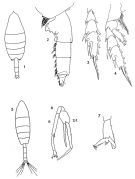 Female: 1, habitus (dorsal); as Euchaeta barbata; issued from : Owre & Foyo in Fauna Carib., 1,. Crustacea, Part 1, Copepoda, 1967: 1-137. 2, Urosome (lateral); issued from Tanaka & Omori, 1968. 3, P2; 4, P2 from P. farrani; issued from Park, 1978. Male: 5, habitus (dorsal); 6, P5 (Dt: right, G: left); 7, distal exopodite of left P5; issued from : Owre & Foyo, 1967, after Sars (1925).
|
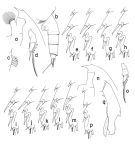 issued from : T. Park in Bull. Scripps Inst. Oceanogr. Univ. California, San Diego, 1995, 29. [p.133, Fig.23]. Female: sample from SE Atlantic: a, forehead (left side); b, urosome (left); c, outer lobe of Mx1; d, exopod of P1 (anterior); e, exopod of P2 (anterior). Second leg exopods of other female specimens: f, from NE Atlantic; g, from the Norwegian Sea; h, from the SE Pacific; i, from the eastern tropical Pacific; j, off northern Japan; k, western Pacific; l, Indian Ocean; m, Tasman Sea. Nota: Similar in habitus to P. malayensis but rostrum pointing more forward, genital prominence at a more anterior position, its posterior margin meeting ventral wall of somite at a wider angle, and tubercle on left side of genital somite much higher. Outer lobe of Mx1 with 5 long setae and 1 minute seta proximally. In P1 exopod, outer spine of 2nd segment far short of reaching base of following outer spine. In P2 exopod, although varying considerably in length in proportion to body size, outer spine of 2nd segment usually longer than 2nd outer spine of 3rd segment; marginal lobe bearing 2nd outer spine of 3rd segment separated from segment by a moderately deep incision, which is far short of reaching level of preceding incision. Male: n, forehead (left); o, exopod of P1 (anterior); p, exopod of P2 (anterior); q, second exopodal segment of left 5th leg (anterior)
|
 issued from : T. Park in Antarctic Res. Ser. Washington, 1978, 27. [p.260, Fig.105]. As Euchaeta farrani. Female: A, forehead (lateral); B, C, D, distal end of metasome and genital segment (left side, right side, and ventral, respectively); E, posterior part of metasome and urosome (dorsal); F, P1; G, P2. P1-2: legs (anterior; Euchaeta barbata female: H, exopod of P2 (anterior).
|
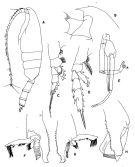 issued from : T. Park in Antarctic Res. Ser. Washington, 1978, 27. [p.262, Fig.106]. As Euchaeta farrani. Male: A, habitus (lateral); B, forehead (lateral); C, P1; D, P2; E, P5; F, G, H, distal part of exopod of left P5 (medial, anterolateral, and anterior, respectively). P1, 2,5: legs (anterior). Nota from Bradford & al; (1983, p.28): - P1 exopod: Aa minute; Bb = 2/5 BC; Cc ± 1/2 BC. - P2 exopod: Aa < 1/2 AB; Bb < 1/2 BC; Cc <1/2 CD. (see code of lengths outer spine in the Genus' figure of Paraeuchaeta, or in Paraeuchaeta sp. A).
|
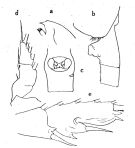 issued from : O. Tanaka in Publs Seto Mar. Biol. Lab., 1958, VI (3). [p.339, Fig.67]. As Pareuchaeta barbata. Female: a, forehead (lateral left side); b, last thoracic segment and urosome segments (lateral left side); c, genital somite (ventral); d, exopod of P1; e, exopod of P2. Nota: The urosome segments and furca are in the proportional lengths as 42:21:23:4:10 = 100. A1 extends in the middle of the 2nd urosome segment.
|
 issued from : O. Tanaka & M. Omori in Publs Seto Mar. Biol. Lab., 1968, XVI (4). [p.228, Fig.5]. As Pareuchaeta barbata. Female: A, last thoracic segment and urosome (lateral left side); B, Mx1.
|
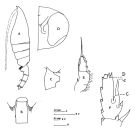 issued from : J.M. Bradford, L. Haakonssen & J.B. Jillett in Mem. N.Z. Oceanogr. Inst., 1983, 90. [p.29, Fig.11]. Female: A, habitus (lateral left side); B, genital segment (dorsal); C, idem (lateral right side); D, genital field (ventral, half); E, exopod of P1; F, exopod segment 3 of P2. Nota: - P1 exopod: Aa >1/5 AB; Bb = 5/6 BC; Cc = 1.1/3 BC. -P2 exopod: Aa < AB; Bb < 1/2 BC; Cc ≤ CD. (see code of lengths outer spine in the Genus' figure of Paraeuchaeta, or in Paraeuchaeta sp. A). For the authors this species is almost identical with descriptions of P. farrani (see Park, 1978), which is probably a junior synonym of P. barbata. For Park (1978) the only distinguishing character between female P. barbata and P. farrani (the length of P2 exopod segment 3 second outer edge spine) appears to vary to some extent with body size (the spine tends to be longer as the body size decreases). In the present specimen from south-west pacific, although small (8.1 mm), P2 exopod Cc < CD (fig.13: E), and so would be attribuate to P. farrani if P. barbata and P. farrani prove to be distinct species.
|
 issued from : F.C. Ramirez in Contr. Inst. Biol. mar., Buenos Aires, 1969, 98. [p.64, Lam. XII, figs.85, 88 ]. Female (from off Mar del Plata): 85, genital complex (ventral); 88, genital somite (lateral left side). Scale bars in mm: 0.05 (85); 0.4 (88).
|
 issued from : F.C. Ramirez in Contr. Inst. Biol. mar., Buenos Aires, 1969, 98. [p.62, Lam. XI, fig.80 ]. Female (from off Mar del Plata): 80, urosome (lateral right side) Scale bar in mm: 0.4.
|
 Issued from : G.O. Sars in Résult. Camp. Scient. Prince Albert I, 69, pls.1-127 (1924). [Pl. XXXI, figs.1-7]. As Pareuchaeta barbata. Female: 1, habitus (lateral left side); 2, forehead (lateral); 3, genital segment (lateral left side); 4, genital complex (ventral). Male: 5, P5; 6, distal end of left P5 (enlarged); 7, denticulate lamella (enlarged).
|
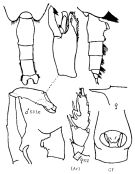 Issued from : K.A. Brodskii in Calanoida of the Far Eastern Seas and Polar Basin of the USSR. Opred. Fauna SSSR, 1950, 35 (Israel Program for Scientific Translations, Jerusalem, 1967) [p.209, Fig.122]. As Pareuchaeta barbata. Female (from central Arctic): urosome (dorsal and lateral right side); forehead (lateral); genital segment (lateral left side and ventral); S2, P2. Male: P5 (distal segments of left leg).
|
 issued from : R.B.S. Sewell in Mem. Indian Mus., 1929, X. [p.156, Fig.59]. Female (from off SE Sri-Lanka): a, posterior thoracic margin and genital segment (lateral left side); b, Mx2; c, Mxp.
|
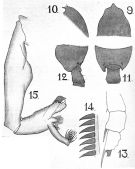 issued from : A. Scott in Siboga-Expedition, 1909, XIX a. [Plate XXI, Figs.9-15]. As paraeuchaeta sarsi. Male (from Banda Sea): 9, forehead (dorsal); 10, idem (lateral); 11, last thoracic and genital segments (dorsal); 12, idem (lateral); 13, P1 (exopodite only); 14, part of terminal spine (exopodite of P3); 15, P5 (part of left leg).
|
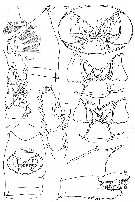 issued from : M.V. Heptner in Trudy. Inst. Okeanol., 1971, 92. [p.78, Fig.1]. Female (from Kuril-Kamchatka Trench). Nota : Formula of the exopod of P1 spines on the last two segments, successively : Aa ≈ 1/5 AB; Bb < BC (Bb ≈ 3/4 BC); Cc ≥ BC (Cc ≈ 1 1/3 BC). P2: Aa ≤ Ab; Bb < BC (Bb ≈ 1/2 BC); Cc < CD (Cc = 4/5 CD). Variant: Aa > Ab (Aa = Ab + 1/3 Bb); Cc ≈ 3/4 CD. [cf. legend in drawings of Heptner, 1971, for Pareuchaeta rubra] Male: ld, left exopod of P5.
|
 issued from : G.P. Farran in Fish. Ire. Sci. Invest., 1906, II [1908]. [Pl. III, Figs.13-14]. As Euchaeta barbata. Female (from W Ireland): 13, genital segment (lateral); 14, exopod of P2.
|
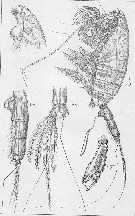 issued from : Sars G.O. in An Account of the Crustacea of Norway, with short descriptions and figures of all species. Vol. IV. Copepoda Calanoida. Publ. by The Bergen Museum. 1903. [Pl. XXVIII]. As Euchaeta barbata. Female & P5 Male.
|
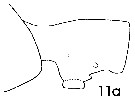 issued from : J. Mauchline in ICES Ident. Leafl. Plankton, 1999, N°182. [p.3, Fig.2: 11a]. As Euchaeta barbata and E. barbata f. farrani. Female (Northeast Atlantic): 11a, genital double-somite (left side).
|
 issued from : J. Mauchline in ICES Ident. Leafl. Plankton, 1999, N°182. [p.4, Fig.3: 11b]. As Euchaeta barbata and E. barbata f. farrani. Male (Northeast Atlantic): 11b, terminal two segments, exopodal segments of left P5.
|
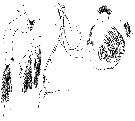 Issued from : G.S. Brady in Rep. Scient. Results Voy. Challenger, Zool., 1883, 8 (23). [Pl.XXII, Figs.6-12]. As Euchaeta barbata. Female: 6, A1; 7, rostrum; 8, Mx2; 9, one of the proximal setae of mx2 with base; 10, portion of one of the larger setae of Mx2 (more highly magnified); 11, P2; 12, urosome with posterior angle of thorax (lateral)
|
 issued from : C. With in The Danish Ingolf-Expedition, Copepoda I, 1915, III, 4. [p.175, Text-fig. 49, a-c, e]. As Euchaete barbata. Female (from 61°30'N, 17°08'W): a-b, genital segment of two specimens (left lateral view); c, same (dorsal view); e, right P1 (exopodal segment 1, outer margin; anterior view).
|
 issued from : C. With in The Danish Ingolf-Expedition, Copepoda I, 1915, III, 4. [p.175, Text-fig. 49, d]. As Euchaete barbata. Female: d, genital complex (ventral view).
|
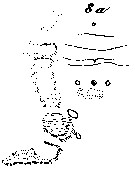 issued from : C. With in The Danish Ingolf-Expedition, Copepoda I, 1915, III, 4. [Pl. VI, Fig.8, a]. As Euchaete barbata. Female: a, labrum (oral view).
|
 issued from : C. With in The Danish Ingolf-Expedition, Copepoda I, 1915, III, 4. [p.175, Text-fig. 49, f-i]. As Euchaete barbata. Male: f-g, lateral corner and genital segment (left and right lateral); h, right P5 (exopod); i, lrft P5 (endopod from inner side).
|
 issued from : C. With in The Danish Ingolf-Expedition, Copepoda I, 1915, III, 4. [Pl. VI, Fig.8, b]. As Euchaete barbata. Male:b, left P5 (2nd and 3rd exopodal segments).
|
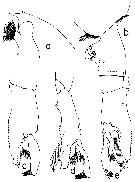 issued from : T. Park in Smiths. Contr. Zool., 1975, 196. [p.9, Fig.7]. As Euchaeta barbata. Female (G. of Mexico): a, forehead (lateral); b, genital segment (lateral). Male: c, exopod of left P5 (lateral); d, same (anterior); e, same (medial). This species was found in tows down to depths of 1000 to 3000 m.
|
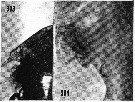 issued from : H.B. Owre & M. Foyo in Fauna Caribaea, 1967, 1, Crustacea, 1: Copepoda. [p.52, Figs.303-304). As Euchaeta barbata. Female (from Florida Current): 303, forehead (lateral); 304, genital segment (left side).
|
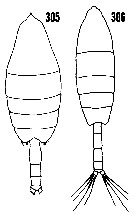 issued from : H.B. Owre & M. Foyo in Fauna Caribaea, 1967, 1, Crustacea, 1: Copepoda. [p.52, Fiogs.305-306]. As Euchaeta barbata. Female (from Florida Current): 305, habitus (dorsal). Male: 306, habitus (dorsal).
|
 Paraeuchaeta barbata Paraeuchaeta barbata Female: 1 - See key to species Groups and independent species of Paraeuchaeta (p.30): malayensis species Group. 2 - Outer spine of 2nd exopodal segment (or the 2nd of the first 2 exopodal segments forming a proximal, compound segment) of P1 normally developed (Fig.23-d, o). 3 - Outer lobe of Mx1 with 5 long setae in addition to a minute seta proximally (Fig.23-c). 4 - Laterally, genital prominence low with more or less convex genital flanges. 5 - Laterally, rostrum well developed (Fig.23-a). 6 - Laterally, posterior margin of genital prominence distinct from posterior ventral wall of somite (Fig.23-b). 7 - Genital somite with conspicuous conical process on left side (Fig.23-b).
|
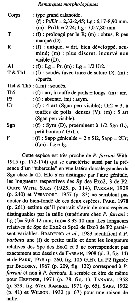 Issued from : C. Razouls in Ann. Inst. océanogr., Paris, 1994, 70 (1). [p.87]. Caractéristiques morphologiques de Paraeuchaeta barbata femelle et mâle adultes. Terminologie et abbréviations: voir à Calanus propinquus.
| | | | | Compl. Ref.: | | | Lee & al., 1971 (p.1152); Kosobokova & al., 1998 (tab.2); Suarez-Morales & Gasca, 1998 a (p.109); Razouls & al., 2000 (p.343, Appendix); Yamaguchi & al., 2002 (p.1007, tab.1); Auel & Hagen, 2005 (p.1272, Table 2); Ikeda & al., 2006 (p.1791, Table 2); Kosobokova & al., 2007 (p.919, Tab.3, 6, fig.2); Morales-Ramirez & Suarez-Morales, 2008 (p.520); Galbraith, 2009 (pers. comm.); Park & Ferrari, 2009 (p.143, Table 4, 7: common deep water species, Appendix 1, biogeography, Rem. p.166); Laakmann & al., 2009 (p.741, fig.2, vertical distribution, lipid analysis); Laakmann & al., 2009 (p.679, fig.2, 4, Table 2); Medellin-Mora & Navas S., 2010 (p.265, Tab. 2); Kosobokova & al., 2011 (p.29, Table 2, Rem.: Arctic Basins); Laakmann & al., 2012 (p.535, Table 1, fig.2, Rem.: mol. Biol.); Fierro Gonzalvez, 2014 (p.1, Tab. 3, 5, occurrence, abundance); Smoot & Hopcroft, 2016 (p.1, fig.7, vertical distribution); Bode & al., 2015 (p.268, Table 2, figs.3, 4, chemical components, trophic level); El Arraj & al., 2017 (p.272, table 2); Belmonte, 2018 (p.273, Table I: Italian zones) | | | | NZ: | 21 | | |
|
Distribution map of Paraeuchaeta barbata by geographical zones
|
| | | | | | | | | | | |  issued from : W. Vervoort in B.A.N.Z. Antarctic Reseach Expedition, Reports - Ser. B, Vol. III, 1957 [Fig.69]. As Euchaeta farrani. issued from : W. Vervoort in B.A.N.Z. Antarctic Reseach Expedition, Reports - Ser. B, Vol. III, 1957 [Fig.69]. As Euchaeta farrani.
Chart showing the geographical distribution (white circle) in the seas surrounding the Antarctic continent.
Nota: In this chart the area frequented by whaling vessels has been hatched. The Antarctic circle (66°.5 S) has been drawn as a broken line. The numbers I to VI refer to the sectors into which the Antarctic seas are divided according to Mackintosh (1942) (after Vervoort, 1951). |
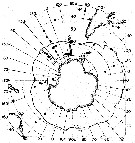 issued from : T. Park in Biology of the Antarctic Seas VII. Antarctic Res. Ser., 1978, 27 (4). [p.264, Fig.107]. issued from : T. Park in Biology of the Antarctic Seas VII. Antarctic Res. Ser., 1978, 27 (4). [p.264, Fig.107].
Occurrence of Euchaeta ( = Paraeuchaeta ) barbata and Euchaeta farrani (= P. barbata).
Crossed circles: stations where barbata was found; closed circles: stations where farrani (= barbata where found. A.C: Antarctic Convergence. |
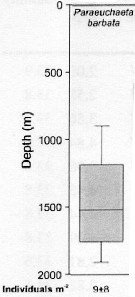 issued from : S. Laakmann, M. Stumpp & H. Auel in Polar Biol., 2009, 32. [p.682, Fig.2]. issued from : S. Laakmann, M. Stumpp & H. Auel in Polar Biol., 2009, 32. [p.682, Fig.2].
Vertical distribution (stages C3 to C6 from Antarctic Polar Front: Atlantic sector).
Error bars encompass the 5th to the 95th percentile. Abundance data are given as mean ± SD.
Nota: This species inhabited the deepest layer between 1,170 and 1,770 m. |
 Issued from : S. Laakmann, M. Kochzius & H. Auel in Deep-Sea Res. I, 2009, 56. [p.745, Fig.2 a]. Issued from : S. Laakmann, M. Kochzius & H. Auel in Deep-Sea Res. I, 2009, 56. [p.745, Fig.2 a].
Vertical distribution abundance of copepodite stages C3 to C6 of Paraeuchaeta spp.
For P. barbata copepodite stages C1 to C6 are included. +: No occurrence; solid line depicts bottom profile (right axis); station 853 over the Yermak Plateau (81°22'N, 6°52'E) is separated from the other stations on the transect; other stations between East Greenland Current, the Fram Strait and the West Spitsbergen Current, into south return Atlantic Current (77°46'N-79°36'N, 6°20'E-7°29'W).
Deep-sea copepods collected from August 20 to September 16, 2006. |
| | | | Loc: | | | Antarct. (Weddell Sea, SW & SE Atlant., Indian, SW & SE Pacif.), South Georgia, sub-Antarct. (SW Atlant., Indian, SW & SE Pacif., South Africa (E), off Angola, G. of Guinea, Canary Is., Azores, Ibero-moroccan Bay, W Medit. (Tyrrhenian Sea), Bay of Biscay, Argentina, Brazil, Caribbean Sea, Caribbean Colombia, G. of Mexico, Florida, off Bermuda: Station "S" (32°10'N, 64°30'W), off Woods Hole, Davis Strait, Baffin Bay, S Iceland, Rockall Is., Faroe Is., off W Ireland, off N Scotland, Norwegian Sea, Norway, Greenland Sea, Arct. (central, Laptev Sea, Nansen Basin, Amundsen Basin, Makarov Basin, Canada Basin, Fletcher's Ice Is.), Sri-Lanka, Indian, Indonesia-Malaysia, Japan, Kuril Is., Station Knot, Pacif. E, British Columbia, off California, off W Guatemala, W Costa Rica, Pacif. (W equatorial), Tasman Sea, off Juan Fernandez Is. | | | | N: | 85 | | | | Lg.: | | | (1) F: 8,3; (3) F: 11,8-7,5; M: 9,1-6,7; (5) M: 7,8; (7) F: 7,87; M: 7,37; (9) F: 8,1; (14) F: 8,9-8,7; (19) F: 8,42-7,58; M: 7,25-6,58; (22) F: 8,4-8; M: 7,5-7; [bassin arctique]: F: 12-10; M: 9,4; (23) F: 10,1-1,0; M: 8,1; (25) F: 10,93; (29) F: 7,25; (35) F: 11; (38) F: 7,5; (45) F: 12-10; M: 10-8; (47) F: 8,4; (49) F: 8,3; (63) F: 10,82-8,29; (65) F: 12; M: 10; (70) F: 10,4-9,3; (99) F: 6,17; (199) F: 7,52; (254) F: ±6; (377) F: 9,94; (866) M: 6,1-9,5; (1001) F: 10,85-10,95; {F: 6,-12,00; M: 6,10-10,00} | | | | Rem.: | Meso-bathypelagic.
Sampling depth (Antarct., sub-Antarct.) : 0-700-1000-4000 m. Sargasso Sea: 500-2000 m (Deevey & Brooks, 1977, station "S");
After Farran (1908b, p.41) an examination of Brady's type specimen in the British Museum is partially dried up, and it is impossible to see wether the lateral tubercle on the genital segment were present or not.
For Vervoort (1957, p.83) there has been a considerable amount of confusion about this species, originating from Brady's incomplete description and his drawings. After Vervoort (1957, p.83) Euchaeta farrani With, 1915 is closely related to P. barbata Brady, 1883, but it can be distinguished by the greater length and the shape of the genital somite, of which especially the ventral aspect is of particular importance. Between the descriptions by Farran, With and Sars there are certain minor differences. According to Tanaka, 1958 (p.340) Brodsky's specimen shows some differences.
According to Østvedt (1955) the number of eggs in the sac is very small, the average being 16.7 (12 to 22), for Jespersen (1934) the number of eggs by sac vary from 14 to 18.
After Park (1995, p.37) Paraeuchaeta farrani was originally distinguished from P. barbata mainly by the body size and the relative lengths of the outer spines of the female P2 exopod. Park (1978), however, found considerable variation in the relative lengths of the spines and considerd the two species to be forms of a single species. Mauchline (1992) has reached a similar conclusion regarding the status of the two species in his quantitative analyses of the relative lengths of the spines based on specimens from many different areas of the world's oceans. The female specimens examined by Park (1995) vary widely in body size (between 7.5 and 11.8 mm), and the variation is latitudinal with the largest individuals occurring in the Norwegian Sea, northern Pacific, and Antarctic and the smallest in equatorial waters. The relative length of the 2nd outer spine of the 3rd exopodal segment of the female P2 is negatively related to the body size. When largest individuals from the higher latitudes are compared with the smallest individuals from the equatorial regions, they are clearly distinguishable by body size and the relative lengths of the outer spines of the female P2 exopod; however, when individuals from neighboring localities are compared, the body size and the relative length of the outer spines vary rather gradually from one end to the other of its geographical range, apparently as a function of the water temperature of the habitat. No other morphological differences among individuals from different geographical locations were found in our study. P. farrani is therefore considerd synonym of P. barbata. It has not been possible to rule out the possibilities of P. barbata being a species complex consisting of two or more cryptic species. However Park (1978, p.261) points to the possibilities that the populations in the northern Atlantic, northern Pacific, and Antarctic each constitute an independently evolving cohort, which may prove to be a separate species. | | | Last update : 24/10/2022 | |
|
|
 Any use of this site for a publication will be mentioned with the following reference : Any use of this site for a publication will be mentioned with the following reference :
Razouls C., Desreumaux N., Kouwenberg J. and de Bovée F., 2005-2025. - Biodiversity of Marine Planktonic Copepods (morphology, geographical distribution and biological data). Sorbonne University, CNRS. Available at http://copepodes.obs-banyuls.fr/en [Accessed November 19, 2025] © copyright 2005-2025 Sorbonne University, CNRS
|
|
 |
 |


































